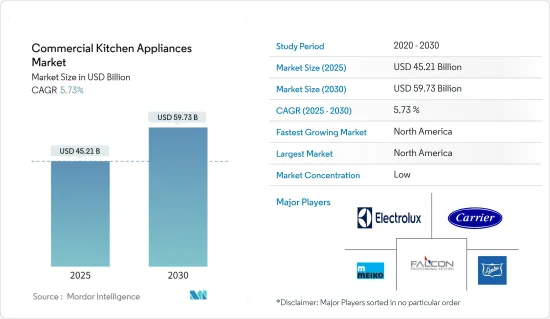 |
市场调查报告书
商品编码
1689856
商务用厨房设备:市场占有率分析、产业趋势与统计、成长预测(2025-2030 年)Commercial Kitchen Appliances - Market Share Analysis, Industry Trends & Statistics, Growth Forecasts (2025 - 2030) |
||||||
※ 本网页内容可能与最新版本有所差异。详细情况请与我们联繫。
预计 2025 年商务用厨房设备市场规模为 452.1 亿美元,到 2030 年将达到 597.3 亿美元,预测期内(2025-2030 年)的复合年增长率为 5.73%。

商务用厨房设备市场正在蓬勃发展。商务用厨房设备包括餐厅使用的烤箱、冰箱、烹调器具等。商务用厨房设备用于餐厅、饭店、俱乐部等的烹饪、清洗和储存。由于偏好的变化、劳动人口的增长和生活方式的改变,外出用餐变得越来越流行。此外,酒店业的扩张、对食品安全的日益担忧以及对快餐店而非全方位服务餐厅的偏好日益增加,预计将推动市场扩张。
此外,餐饮业的技术进步,例如推出新的尖端产品和经济实惠、节能的商务用厨房设备,预计将在未来几年创造广阔的成长前景。然而,随着餐厅和其他食品服务企业重新开业,商务用厨房设备市场开始復苏。为了遵守新的健康和安全法规,许多餐厅正在投资新的厨房设备,包括非接触式技术和增强空气过滤系统。
商务用厨房设备的市场趋势
引进智慧厨房设备
人们对智慧家庭和技术的认识不断增强,导致对智慧厨房电器的需求增加。结合物联网和人工智慧的厨房电器提供许多功能,使用户的生活更加便利。整合到厨房电器中的技术可以帮助分析资料、识别模式并节省能源消耗。消费者意识到全球暖化和气候变迁的影响,因此致力于保护环境。客户需要绿色节能的产品,例如透过自动化优化能源消耗的智慧厨房电器。
在所有地区中,北美的成长速度最快。
- 北美是商务用厨房设备市场收益最高的地区,预计在预测期内仍将继续保持这种成长势头。该地区的成长主要归功于餐饮业从业者的高消费能力。餐饮业的新进业者正在购买各种商务用烹调器具来改善菜单并提高厨房性能,从而推动了市场的成长。
- 此外,该地区食品卡车和速食店的兴起也推动了市场的成长。其他推动北美市场成长的因素包括不同的饮食习惯、各种菜系的日益普及以及多元文化环境。
商务用厨房设备产业概况
商务用厨房设备市场资金密集且分散,众多参与者相互竞争以维持其市场地位。该行业本质上是充满活力的,技术进步迅速。参与者正在加大对创新产品的投资。商务用厨房设备市场的主要企业包括伊莱克斯、Meiko International、Falcon Professional Kitchens LLC、开利公司和 Rational AG。
其他福利
- Excel 格式的市场预测 (ME) 表
- 3 个月的分析师支持
目录
第 1 章 简介
- 调查结果
- 研究范围
第二章调查方法
第三章执行摘要
第四章 市场动态与洞察
- 市场概况
- 市场驱动因素
- 市场限制
- 产业价值链分析
- 波特五力分析
- 供应商的议价能力
- 买家的议价能力
- 新进入者的威胁
- 替代品的威胁
- 竞争对手之间的竞争强度
- 洞察商务用厨房电器创新
- 消费行为分析洞察
第五章 市场区隔
- 按类型
- 冰箱
- 烹饪用具
- 烹饪加热器和烹饪炉灶
- 烤箱
- 洗碗机/烘干机
- 其他类型
- 按应用
- 速食店 (QSR)
- 铁路食堂
- 引擎餐厅
- 渡假饭店
- 医院
- 全方位服务餐厅 (FSR)
- 其他用途
- 按地区
- 北美洲
- 南美洲
- 亚太地区
- 欧洲
- 中东和非洲
第六章 竞争格局
- 市场集中度概览
- 公司简介
- Ali Group
- American Range
- Carrier Corporation
- Electrolux
- Fagor Group
- Hamilton Beach
- Hobart
- Hoshizaki Corporation
- Interlevin Refrigeration Ltd
- Rational AG
- Meiko International
- Southbend
- Falcon Group
- Duke Manufacturing Company
- Vulcan
- The Vollrath Company LLC*
第七章 市场机会与未来趋势
第 8 章 附录
The Commercial Kitchen Appliances Market size is estimated at USD 45.21 billion in 2025, and is expected to reach USD 59.73 billion by 2030, at a CAGR of 5.73% during the forecast period (2025-2030).

The market for commercial kitchen appliances is flourishing. Commercial kitchen appliances include ovens, refrigerators, and culinary utensils that are utilized in restaurants. Commercial kitchen appliances are used for cooking, cleaning, and storing in restaurants, hotels, and clubs. Due to shifting customer preferences for outside food, a rise in the working population, and lifestyle changes, restaurants are becoming more and more popular. In addition, the expanding hospitality sector, growing apprehensions over food safety, and a growing inclination towards quick-service restaurants relative to full-service restaurants are all expected to fuel market expansion.
Additionally, technical advancements in the food service sector, such as the introduction of cutting-edge new goods and reasonably priced, energy-efficient commercial kitchen appliances, are anticipated to create a wide range of growth prospects in the years to come. The market for commercial kitchen appliances did, however, start to rebound as eateries and other food service businesses started to reopen. To adhere to new safety and sanitary regulations, many restaurants are investing in new kitchen equipment, such as touchless technologies and enhanced air filtering systems.
Commercial Kitchen Appliances Market Trends
The Introduction Of Smart Kitchen Appliances
There is an increased demand for smart kitchen appliances due to the rising awareness about smart homes and technology. The combination of IoT and AI kitchen appliances offers many features that make users' lives more accessible. The integrated technologies in kitchen appliances help analyze data, identify patterns, and save energy consumption, which is aimed at environmental preservation because consumers are aware of the global warming effects and climate change; customers demand eco-friendly and energy-efficient products like intelligent kitchen appliances, which optimize energy consumption through automation.
North America Is Witnessing Highest Growth Among All Regions
- North America generated the highest revenue in the commercial kitchen appliances market, and it is expected to witness this growth in the forecast period. The growth in this region is mainly attributed, owing to the high spending capacity of the people starting a restaurant business. The new entrants in the restaurant business are purchasing a range of commercial cookware to improve the menu and also raise the kitchen performance, which is fuelling the growth of the market.
- Furthermore, the increasing number of food trucks and fast-food joints in this region is also fuelling the market growth. Other factors supporting market growth in North America include different eating habits, the increasing popularity of different cuisines, and a multicultural environment.
Commercial Kitchen Appliances Industry Overview
The commercial kitchen appliances market is capital-intensive and fragmented, as numerous players compete with one another to uphold their place in the market. The industry is dynamic in nature, with rapid technological advancements. The players are increasingly investing in innovating their product offerings. Some of the major players in the commercial kitchen appliances market include Electrolux, Meiko International, Falcon Professional Kitchen L.L.C, Carrier Corporation, and Rational AG.
Additional Benefits:
- The market estimate (ME) sheet in Excel format
- 3 months of analyst support
TABLE OF CONTENTS
1 INTRODUCTION
- 1.1 Study Deliverables
- 1.2 Scope of the Study
2 RESEARCH METHODOLOGY
3 EXECUTIVE SUMMARY
4 MARKET DYNAMICS AND INSIGHTS
- 4.1 Market Overview
- 4.2 Market Drivers
- 4.3 Market Restraints
- 4.4 Industry Value Chain Analysis
- 4.5 Porter's Five Forces Analysis
- 4.5.1 Bargaining Power of Suppliers
- 4.5.2 Bargaining Power of Buyers
- 4.5.3 Threat of New Entrants
- 4.5.4 Threat of Substitutes
- 4.5.5 Intensity of Competitive Rivalry
- 4.6 Insights on Technological Innovations in Commercial Kitchen Appliances
- 4.7 Insights on Consumer Behavior Analysis
5 MARKET SEGMENTATION
- 5.1 By Type
- 5.1.1 Refrigerators
- 5.1.2 Cooking Appliances
- 5.1.3 Cooktop and Cooking Ranges
- 5.1.4 Ovens
- 5.1.5 Dishwashers
- 5.1.6 Other Types
- 5.2 By Application
- 5.2.1 Quick Service Restaurant (QSR)
- 5.2.2 Railway Dining
- 5.2.3 Institutional Canteen
- 5.2.4 Resort and Hotel
- 5.2.5 Hospital
- 5.2.6 Full Service Restaurant (FSR)
- 5.2.7 Other Applications
- 5.3 By Geography
- 5.3.1 North America
- 5.3.2 South America
- 5.3.3 Asia-Pacific
- 5.3.4 Europe
- 5.3.5 Middle East & Africa
6 COMPETITIVE LANDSCAPE
- 6.1 Market Concentration Overview
- 6.2 Company Profiles
- 6.2.1 Ali Group
- 6.2.2 American Range
- 6.2.3 Carrier Corporation
- 6.2.4 Electrolux
- 6.2.5 Fagor Group
- 6.2.6 Hamilton Beach
- 6.2.7 Hobart
- 6.2.8 Hoshizaki Corporation
- 6.2.9 Interlevin Refrigeration Ltd
- 6.2.10 Rational AG
- 6.2.11 Meiko International
- 6.2.12 Southbend
- 6.2.13 Falcon Group
- 6.2.14 Duke Manufacturing Company
- 6.2.15 Vulcan
- 6.2.16 The Vollrath Company LLC*










